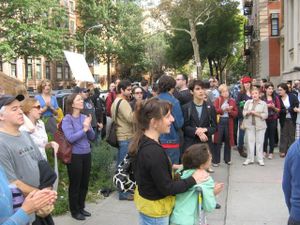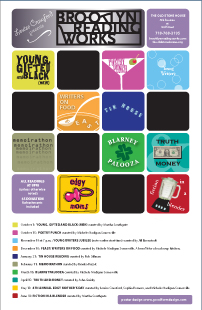Park Slope's Dr. Philippa Gordon has taken the time to answer some urgent questions about this flu season and the vaccine. This appeared on Park Slope Parents and with her permission is on OTBKB. She writes: "I am already working triple time fielding questions, and I anticipate
it only getting worse as the vaccine is released and as flu cases
start occurring. So the more info out there, the better. I will
continue to post answers to questions that psp'ers send me off line,
and you may feel free to use them also, also to let me know if there's
any other info you think is needed."
1.Why is this flu different from all other flus?
The flu virus changes (shifts) slightly every year, enough to cause
annual epidemics — the normal community-wide outbreaks that we
experience every winter. But every once in a while — 3 times per
century on average –a major change (drift) occurs, resulting in a
novel strain. It is so different from all other strains that even if
you've
been exposed to or vaccinated against all previous flu strains in your
lifetime, you are unlikely to be immune to it. Therefore there are
widespread outbreaks all over the world — a pandemic.
2. Will there be a vaccine for this novel pandemic flu? Will it be
safe since it is so new?
Yes
— in October. Since the strain was first isolated last year, the
vaccine makers have been working on it. Although it is a new strain,
the vaccine is made just the way other flu vaccines are made —
immunologically, every flu vaccine is specific to the strain expected
to emerge that season, and therefore new every year –but the basic
recipe, if you will, for the vaccine is exactly the same. So it is
neither newer nor more experimental than the annual flu vaccine, which
has a good safety record. Moreover, since the H1N1 strain has remained
very stable since its emergence, we know that the vaccine is a good
match for the virus, whereas the annual vaccine may sometimes miss the
mark a bit.
3. Will there be special chemicals that are untested added to this vaccine?
No. Some
vaccines have immune- stimulating compounds called adjuvants added to
them, and there was some discussion of adding these compounds to the
H1N1 vaccine in the event that the vaccine supply fell short, butthe
discussion was theoretical only and these technologies have not been
implemented in the US.
4.Does the H1N1 vaccine contain mercury or thimerosal?
All flu vaccines are available in thimerosal-free formulations.
5. Who should get H1N1 vaccine and will seasonal flu vaccine protect
against the H1N1 strain?
Eventually,
as supplies permit it, widespread vaccination will truncate this
pandemic (the first of the century). For the present, vaccine is
being triaged to pregnant women and children, as well as those with
chronic illnesses. This is because so far, more cases have been
occurring in children, perhaps because older people have partial
resistance, and because pregnant women are at higher risk for
complications. An added benefit is that the infants of vaccinated
women
will be born with some immunity to this strain. Seasonal flu
vaccine is recommended for everyone age 6 months and up, especially
pregnant women. Seasonal flu vaccine does not appear to give any
protection against the H1N1.
6. Since seasonal flu is usually mild, and since so far the H1N1 is
tending to be clinically mild, is it necessary to be vaccinated? Why
not just catch the flu, and take anti-flu drugs such as Tamiflu
(oseltamivir)?
Influenza is usually a mild and self-limited disease. It tends to
be more severe in young children, the elderly, pregnant women, and
people with chronic illnesses. However, the majority of the 40,000
deaths
and 200,000 hospitalizations per year from influenza in the USA occur
in previously healthy people. Since flu is so highly contagious,
eating well, taking supplements, and following guidelines for healthy
living, are not helpful strategies for preventing infection , or for
preventing complications of infection which may lead to
hospitalization, severe illness, or death. In the current pandemic,
more deaths would be expected in the pediatric age group as more cases
are occurring in children. Another factor in the estimated burden of
disease has to do with the number of acute or intensive care beds
available, and the number of respirator machines available throughout
the country. In a serious pandemic it is possible that the nation's
capacity for acute respiratory support would simply be overwhelmed.
Currently, anti-flu medications are recommended only for children
under age 2, hospitalized patients, and those with underlying chronic
disease. It is desirable to restrict use of these drugs to prevent
viruses from developing resistance to them. Widespread use of
currently available vaccines will decrease the number of cases and the
duration of outbreaks, and thus the overall burden of disease in our
communities.
In recent years, especially in Great Britain and the USA,
vaccination
has taken on other social meanings, associated with fear of
environmental toxins, suspicion of the government and pharmaceutical
industry, fear of neurologic damage or long-term side effects, or the
desire to raise one's children in a simple or more natural fashion. It
is legitimate for individuals to take these issues into consideration
as long as the risks are clearly understood — this is informed
consent. Those choosing, with full knowledge of the facts, to decline
the flu vaccine, are making an acceptable decision both ethically and
legally, as this vaccine is not mandatory. Those who do not have such
fears or objections should feel comfortable in taking the vaccine,
because the more uptake of vaccine, the less disease, and the less
disease, the fewer adverse outcomes will occur. Widespread uptake of
vaccine not only safeguards individual health, but contributes to the
health of the community.
7. How much will the vaccine cost? Will insurance cover it? How will it be administered?
All
doses of the H1N1 vaccine have been purchased by the government, and
will be distributed through state and local health departments.
Strategies
for distribution will vary from place to place. There is no charge for
the vaccine itself, although there may be an office visit or
administrative fee charged by clinics and private offices.
Both
seasonal and pandemic flu vaccines are available in an injectable form
which is made from killed virus, and in a nasal spray containing live
virus which has been weakened, or attenuated, so that it cannot cause
infection. Nose spray can be used in healthy patients aged 2 through
49 years, who do not have asthma or egg allergy.
As regards
co-administration of the vaccine, most patients age 9 and up will
receive one dose of each vaccine, in either or both modalities.
Children age 8 and younger will need 2 doses of the H1N1 vaccine, and
1 dose of seasonal flu vaccine, and children receiving the seasonal flu
vaccine for the first time in their lives will need two doses of that
vaccine as well. Final details regarding the timing of multiple doses
in young children and the mixing of the two forms of the vaccine will
be determined and made public when the vaccine is released for
administration in the next few weeks.
Sources: Red Book of the American Academy of Pediatrics, CDC.gov,
Mandell's Principles and Practice of Infectious Diseases,Elsevier 2005.
Submitted by Philippa Gordon



















